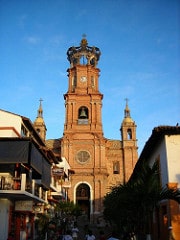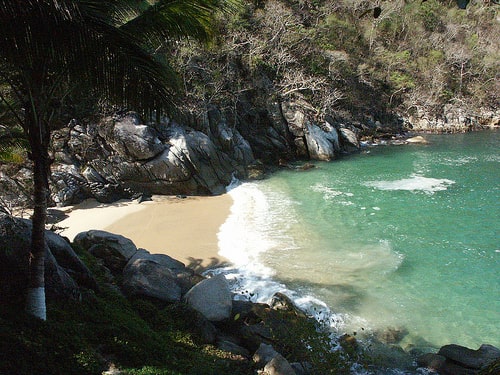Bahía Banderas, Banderas bay, is the third largest natural bay in Mexico, and it’s divided almost equally between two states – Jalisco, where Puerto Vallarta is, and Nayarit, which begins an eight-minute drive north of the international airport in the middle of the Ameca River Bridge. The agricultural valley of the Ameca River and the important mining centers in the Sierra have given the town a very interesting past. The tourist destination of Puerto Vallarta, is bounded on the north by Punta Mita and on the south by Cape Corrientes.
Few details are known about the history of the area prior to the 19th century. There is some archeological evidence that the area belonged to the Aztatlán culture. The valley was then named Banderas (flags) after the colorful standards carried by the natives in the large battle between them and Hernan Cortez, in 1524.
During the 17th and 18th centuries the Banderas Valley and its beaches along the Bay of Banderas served as supply points for ships seeking refuge in the bay. In 1851 a boatman from Cihuatlán who used to bring salt to Los Muertos beach, became tired of waiting for the muleteers to come and pick up the load. So he saw it fit to establish himself in this beautiful place he would call Las Peñas. At the time the main port serving Jalisco was located at San Blas, but the inconvenient overland route from San Blas to the Sierra towns made Puerto Vallarta a more convenient alternative for smaller shipments. By the mid 19th century, the town already had its regularly returning population of vacationers. Las Peñas development into a self-sustaining village happened in the 1860’s, and in 1918 was renamed after a former state governor, Ignacio Vallarta.

Our Lady of Guadalupe at sunset, Puerto Vallarta, Mexico
In 1942 in the New York based magazine Modern Mexico the first advertisement for a Puerto Vallarta vacation appeared, the page ad offered a flight from Guadalajara to a “primitive place of hunting and fishing”. Reinforced by intense advertising campaigns, Mexicana launched the Puerto Vallarta-Mazatlán-Los Angeles route in 1962.
In 1963, the director John Huston filmed “The Night of the Iguana” in a small town at south of Puerto Vallarta. For the first time received simultaneously big Hollywood Stars, national celebrities and intellectuals. Deborah Kerr, Ava Gardner, Sue Lyon and Richard Burton led the cast that also included Emilio “El Indio” Fernández. Tennessee Williams, author of “The Night of the Iguana,” visited the set frequently. During the filming, the US media gave extensive coverage to Elizabeth Taylor’s extramarital affair with Richard Burton. The subsequent publicity helped put Puerto Vallarta on the map for US tourists.
In the late 1960’s and early 1970’s, Puerto Vallarta was outfitted with the infrastructure required of an urban development and a modern tourist destination. The Mexican government invested in the development of highways, airport and utility infrastructure, making Puerto Vallarta easily accessible both by air and ground transportation for the first time.
It was only after 1973 that the construction of large hotels began. It experienced rapid growth in the number of larger luxury hotels, culminating in 1980 with the opening of the Sheraton Buganvilias. In 1982 the peso was devalued and Puerto Vallarta enjoyed a period of prosperity, it became a bargain destination for US tourists.
By 1985 the flux of tourism and immigrants demanded, on one hand, the building of new hotels and, on the other, the development of residential options for employees and executives. So while more and more workers were arriving in Puerto Vallarta to try to cash in on the booming tourist trade, less and less was being done to accommodate them with housing and related infrastructure. During the late 1980s the city worked to alleviate the situation by developing housing and infrastructure.
By the early 90s development of other destinations in Mexico like Ixtapa and Cancún caused a slump in travel to Puerto Vallarta. The efforts of the trust, of individual hotels and restaurants, free agents, gallery owners, tour operators and guardians of the environment created the miracle needed and Puerto Vallarta began the process of earning a position among world-class beach destinations.

Hiking expeditions in Puerto Vallarta
